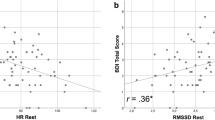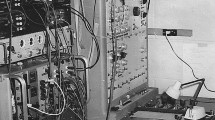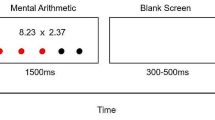Abstract
Idiodynamics offers a conceptual foundation upon which alternatives to the prevailing model of cardiovascular reactivity could be advanced, built upon systematic investigations of individuals. The origins of a union of idiodynamics and psychophysiology are described, accompanied by an empirical study that exemplifies this synthesis. In the study, a montage of cardiovascular measures was used to assess autonomic patterns in six subjects across a range of laboratory tasks on three occasions. Cardiovascular profiles were derived with p-technique factor analysis and then group aggregated with chain p-technique. The group pattern suggested three components: rate, contractility, and peripheral resistance. When individual profiles were compared to the group, consistencies and disparities appeared. Differences in the number of factors, percentage of variance explained, and dominance of specific components distinguished subjects from one another, leading to a hypothesis about underlying cardiovascular complexity. Idiodynamics, combined with novel methodologies, can expand the construct of reactivity beyond traditional stimulus-response conceptualizations.
Similar content being viewed by others
References
Allen, M.T., & Crowell, M.D. (1989). Patterns of autonomic response during laboratory stressors. Psychophysiology, 26, 603–614.
Allport, G.W. (1962). The general and the unique in psychological science. Journal of persona-lity, 30, 405–22.
Blascovitch, J., & Katkin, E.S. (Eds) (1991). Cardiovascular reactivity to psychological stress and disease. Washington, DC: American Psychological Association; 1991.
Brown, K.W., & Moskowitz, D.S. (1998). It's a function of time: a review of the process approach to behavioral medicine. Annals of Behavioral Medicine, 20, 109–117.
Carroll, D., Smith, G.D., Sheffield, D., Shipley, M.J., & Marmot, M.G. (1995). Pressor reactions to psychological stress and prediction of future blood pressure: data from the Whitehall II study. British Medical Journal, 310, 771–776.
Cattell, R.B. (1988). The data box: its ordering of total resources in terms of possible relational systems. In J.R. Nesselroade & R.B. Cattell (Eds.), Handbook of multivariate experimental psychology (2nd ed.) (pp. 69–130). Chicago: Rand McNally.
Cattell, R.B. (1988b). Psychological theory and scientific method. In J.R. Nesselroade & R.B. Cattell (Eds.), Handbook of multivariate experimental psychology (2nd ed.) (pp. 3–20). Chicago: Rand McNally.
Cliff, N. (1966). Orthogonal rotation to congruence. Psychometrika, 31, 33–41.
Danziger, K. (1990). Constructing the subject: Historical origins of psychological research. Cambridge: Cambridge University Press.
Edwards, A.E., & Hill, R.A. (1967). The effect of data characteristics on theoretical conclusions concerning the physiology of emotions. Psychosomatic Medicine, 24, 303–310.
Fox, S.I. (1987). Human Physiology (2nd ed.). Dubuque, IA: WC Brown Publishers.
Freeman, R. (1990). Autonomic nervous system. In J.H. Stein (Ed.), Internal medicine (3rd ed.) (pp. 1894–1903). Boston: Little Brown & Co.
Friedman, B.H., & Santucci, A.K. (2000). Idiodynamic profiles of cardiovascular reactivity: A p-technique approach. Manuscript submitted for publication.
Friedman, B.H., & Thayer, J.F. (1998a). Anxiety and autonomic flexibility: a cardiovascular approach. Biological Psychology, 49, 313–323.
Friedman B.H., & Thayer, J.F. (1998b). Autonomic balance revisited: panic anxiety and heart rate variability. Journal of Psychosomatic Research, 44, 133–151.
Friedman, B.H., Thayer, J.F., & Borkovec, T.D., Tyrrell, R.A., Johnsen, B.H., & Colombo, R. (1993). Autonomic characteristics of nonclinical panic and blood phobia. Biological Psychiatry, 34, 298–310.
Friedman, B.H., Thayer, J.F., & Tyrrell, R.A. (1996). Spectral characteristics of heart period variability during cold face stress and shock avoidance in normal subjects. Clinical Autonomic Research, 6, 147–152.
Guadagnoli, E., & Velicer, W. (1991). A comparison of pattern matching indices. Multivariate Behavioral Research, 26, 323–343.
Guilford, J.P. (1950). Fundamental statistics in psychology and education (2nd ed.). New York: McGraw-Hill.
Jones, C.J., Nesselroade, J.R. (1990). Multivariate, replicated, single-subject, repeated measures designs and P-technique factor analysis: A review of intraindividual change studies. Experimental Aging Research, 16, 171–183.
Kamarck, T.W. (1992). Recent developments in the study of cardiovascular reactivity: contributions from psychometric theory and social psychology. Psychophysiology, 29, 491–503.
Kaplan, D., Furman, M.I., Pincus, S.M., Ryan, S.M., Lipsitz, L.A., & Goldberger, A.L. (1991). Aging and the complexity of cardiovascular dynamics. Biophysical Journal, 59, 945–949.
Kautzner, J., & Hnatkova, K. (1995). Correspondence of different methods for heart rate variability measurement. In M. Malik, & A.J. Camm (Eds.), Heart rate variability (pp. 119–126). Armonk, NY: Futura Publishing Co.
Kratochwill, T.R., & Levin, J.R. (Eds.) (1992). Single-case research design and analysis: New directions for psychology and education. Hillsdale, NJ: Erlbaum.
Levenson, R.W. (1988). Emotion and the autonomic nervous system: A prospectus for research on autonomic specificity. In H.L. Wagner (Ed.), Social psychophysiology and emotion: Theory and clinical applications (pp. 17–42). Chichester: Wiley.
Luborsky, L., & Mintz, J. (1972). The contribution of P-technique to personality, psychotherapy, and psychosomatic research. In R.M. Dreger (Ed.), Multivariate personality research: contributions to the understanding of aersonality in honor of Raymond B. Cattell (pp. 387–410). Baton Rouge, LA: Claitor's Publishing Division.
Malliani, A., Pagani, M., Lombardi, F., & Cerutti, S. (1991). Cardiovascular neural regulation explored in the frequency domain. Circulation, 84, 482–492.
Mandell, A.J., & Schlesinger, M.F. (1990). Lost choices: parallelism and topological entropy decrements in neurobiological aging. In S. Krasner (Ed.), The ubiquity of chaos (pp. 35–46). Washington, DC: American Association for the Advancement of Science.
Manuck, S. (1994). Cardiovascular reactivity in cardiovascullar disease: “Once more unto the breach.” International Journal of Behavioral Medicine, 1, 4–31.
Manuck, S.B., KasprowiczA.L., & Muldoon, M.F. Behaviorally-evoked cardiovascular reactivity and hypertension: conceptual issues and potential associations. Annals of Behavioral Medicine, 12, 17–29.
Matthews, K.A., Weiss, S.M., Detre, T., Dembroski, T.M., Falkner, B., Manuck, S.B., & Williams, R.B. (Eds.) (1986). Handbook of stress, reactivitv, and cardiovascular disease. New York: Wiley & Sons.
Michela, J.L. (1990). Within-person correlational design and analysis. In C. Hendrick & M.S. Clark (Eds.), Research methods in personality and social psychology (pp. 279–311). Newbury Park, CA: Sage Publications.
Miller, J.G. (1978). Living svstems. New York: McGraw-Hill.
Nesselroade, J.R. (1991). Interindividual differences in intraindividual change. In L.M. Collins & J.L. Best (Eds.), Best methods for the analysis of change (pp. 92–105). Washington, D.C.: American Psychological Association.
Nesselroade, J.R., & Ford, D.H. (1987). Methodological considerations in modeling living systems. In M.E. Ford, & D.H. Ford (Eds.), Humans as self-constructing living systems: putting the framework to work (pp. 47–79). Hillsdale, NJ: Erlbaum.
Obrist, P.A. (1981). Cardiovascular psychophysiolopy. New York: Plenum Press.
Pagani, M., Lucini, D., Rimoldi, O., Furlan, R., Piazza, S., Biancardi, L. (1995). Effects of physical and mental exercise on heart rate variability. In M. Malik, & A.J. Camm (Eds). Heart rate variability (pp. 245–266). Armonk, NY: Futura Publishing Co.
Pickering, T.G., & Gerin, W. (1990). Cardiovascular reactivity in the laboratory and the role of behavioral factors in hypertension: a critical review. Annals of Behavioral Medicine, 12, 3–16.
Rose, G. (1992). Strategies of prevention: the individual and the population. In M. Marmot, & P. Elliot (Eds.), Coronary heart disease epidemiology (pp. 311–324). New York: Oxford University Press.
Rosenzweig, S. (1937). The experimental study of psychoanalytic concepts. Character and Personality, 6, 61–71.
Rosenzweig, S. (1942). The photoscope as an objective device for evaluating sexual interest. Psychosomatic Medicine, 4, 150–158.
Rosenzweig, S. (1943). Psychology of the menstrual cycle. Journal of Clinical Endocrinology, 3, 296–300.
Rosenzweig, S. (1951). Idiodynamics in personality theory with special reference to projective methods. Psychological Review, 58, 213–223.
Rosenzweig, S. (1956). Projective methods and psychometric criteria. Australian Journal of Psycholology, 8, 152–155.
Rosenzweig, S. (1958). The role of the individual and of idiodynamics in psychology: A dialogue. Journal of Individual Psychology, 14, 3–20.
Rosenzweig, S. (1973). Human sexual autonomy as an evolutionary attainment, anticipating proceptive sex choice and idiodynamic bisexuality. In J. Zubin, & J. Money (Eds.), Contemporary sexual behavior: Critical issues in the 1970s. Baltimore, MU: The Johns Hopkins University Press.
Rosenzweig, S. (1978). Aggressive behavior and the Rosenzweig Picture-Frustration Study, New York: Praeger.
Rosenzweig, S. (1984). Idiodynamics. In R.J. Corsini (Ed.), Encyclopedia of psychology (2nd ed.) (pp. 205–208). New York: Wiley & Sons.
Rosenzweig, S. (1985). Freud and experimental psychology: The emergence of idiodynamics. St. Louis: Rana House.
Rosenzweig, S. (1986a). Background to idiodynamics. The Clinical Psychologist, 39, 83–89.
Rosenzweig, S. (1986b). Idiodynamics vis-a-vis psychology. American Psychologist, 41, 241–245.
Rosenzweig, S., & Fisher, S.L. (1997). “Idiographic” vis-a-vis “Idiodynamic” in the historical perspective of personality: remembering Gordon Allport, 1897–1997. Journal of the History of the Behavioral Sciences, 33, 405–419.
Saab, P.G., Llabre, M.M., Hmwitz, B.E., Schneiderman, N., Wohlgemuth, W., Durel, L., Massie, C., Nagel, J. (1999). The cold pressor test: vascular and myocardial responses patterns and their stability. Psychophysiology, 30, 366–373.
Saul, J.P. (1990). Beat-to-beat variations of heart rate reflect modulation of cardiac autonomic outflow. News in Physiological Science 5, 32–37.
Sherwood, A., Allen, M.T., Fahrenberg, J., Kelsey, R.M., Lovallo W.R, & van Doornen, L.J.P. (1990). Methodological guidelines for impedance cardiography. Psychophysiology, 21, 1–23.
Smith, T.W., & Pope, M.K. (1990). Cynical hostility and health risk: Current status and future directions. Journal of Social Behavior and Personality, 54, 77–88.
Stemmler, G., Grossman P., Schmid, H., & Foerster, F. (1991). A model of cardiovascular activation components. Psychophysiology, 28, 367–382.
Sutcliffe, J.P. (1955). An appraisal of the Rosenzweig Picture-Frustration Study. Australian Journal of Psychology, 7, 97–107.
Taylor, M.V., & Taylor, O.M. (1951). Internal consistency of the Group-Conformity Rating of the Rosenzweig Picture-Frustration Study. Journal of Consulting Psychology, 16, 250–252.
Thayer, J.F., & Friedman, B.H. (1997). The heart of anxiety: nonlinear dynamics. In A. Vingerhoets, F. van Bussel F, & J. Boelhouwer (Eds.), The (non) expression of emotion in health and disease (pp. 39–49). Tilburg, The Netherlands: Tilburg University Press.
Thayer, J.F., & Friedman, B.H. (2000). The design and analysis of experiments in engineering psychophysiology. In R.W. Backs, & W. Boucseirr (Eds.), Engineering psychophysiology: Issues and applications (pp. 59–78). Mahwah NJ: Erlbaum.
Thayer, J.F., Friedman, B.H., & Borkovec, T.D. (1996). Autonomic characteristics of generalized anxiety disorder and worry. Biological Psychiatry, 39, 255–266.
Thayer, J.F., Friedman, B.H., Borkovec, T.D., Johnsen, B.H., & Molina, S. (2000). Phasic heart period reactions to cued threat and non-threat stimuli in generalized anxiety disorder. Psychophysiology, 37, 361–368.
Turner, J.R., Sherwood, A., & Light, K. (1992). Individual differences in cardiovascular responses to stress. New York: Plenum Press.
von Baeyer, H.C. (January/February 1990). The Aesthetic Equation. The Sciences, 2–5.
Author information
Authors and Affiliations
Rights and permissions
About this article
Cite this article
Friedman, B.H. Idiodynamics Vis-à-vis Psychophysiology: An Idiodynamic Portrayal of Cardiovascular Reactivity. Journal of Applied Psychoanalytic Studies 5, 425–441 (2003). https://doi.org/10.1023/A:1026019614831
Issue Date:
DOI: https://doi.org/10.1023/A:1026019614831




